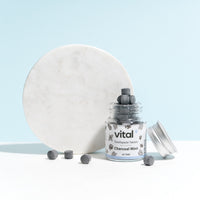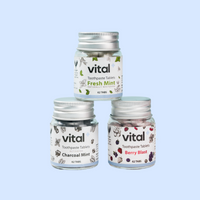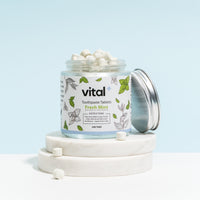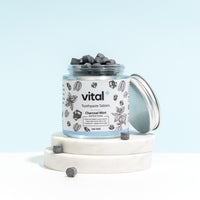What is Nano-Hydroxyapatite? (nHAp)

Nano-hydroxyapatites and protecting your teeth
Our oral cavity is constantly being exposed to acids from what we eat and drink throughout the day, and this exposes our teeth to cycles of remineralization and demineralization. When demineralization occurs, minerals are lost from our teeth due to the production of acids by bacteria within the mouth. In the process of remineralization, the body repairs enamel that has become weakened or worn away by these acids and in this way, it stops minerals from being lost.
One way that this remineralization process occurs is due to saliva that bathes the teeth and contains minerals such as calcium and phosphates which help to strengthen the enamel of teeth and prevent demineralization from occurring.
Another way that this can happen is using toothpastes and mouthwashes that contain fluoride that help to strengthen enamel and remineralize teeth. Perhaps just as effective, but less known is the use of toothpastes containing hydroxyapatite that act in much the same way as fluorides and create a barrier that protects your teeth from harmful bacteria and acids within the oral cavity.
What is hydroxyapatite?
Our teeth have layers, and the outermost layer is composed of enamel. Enamel is the hardest and most mineralized tissue in the human body being made up of 96% inorganic material and 4% organic material and water. In dentine (the layer under enamel), the inorganic material represents 70% by weight, and this inorganic material in both enamel and dentine is mainly made up of hydroxyapatite, a crystalline calcium phosphate.
Hydroxyapatite has consistently been one of the most studied biomaterials in the field of medicine due to its biocompatibility and the fact that it is one of the main constituents in bone and teeth. It is also a very important source of calcium and phosphate which are critical for the remineralization of demineralized areas.
How does hydroxyapatite protect teeth?
When fighting against harmful acids and bacteria, enamel is your tooth’s first line of defense, but to remain strong, it must constantly be remineralized. Fluoride is perhaps the name you are most familiar with when it comes to fighting against cavities, but hydroxyapatite is naturally restorative and effective in preventing cavities and enamel erosion. Also, because hydroxyapatite is naturally occurring, it will safely rebuild your enamel and keep your smile healthy and strong.
Hydroxyapatite works to remineralize our teeth by replacing minerals that are lost such as calcium and phosphate due to acid attack from bacteria. Remineralization occurs by filling in microscopic cracks in our teeth that occur because of tooth decay, and this can be done in conjunction with saliva.
Other benefits of hydroxyapatite include the fact that it is:
- Anti-microbial
- Lowers plaque levels
- Naturally whitens teeth
- Reduces tooth sensitivity
- Remineralizes teeth
- Soothes gums and fights against gingivitis
- No systemic side-effects or toxicity
What is Nano-hydroxyapatite?
The synthetic version of hydroxyapatite is called nano-hydroxyapatite (nHA) and it has not only been shown to help remineralize and repair teeth, but it has also been shown to be able to do the same for bones, and as such, is used in the fields of dentistry, orthopedics, and osteopathy, both in products and treatment.
First used by NASA on astronauts in the 1970’s who returned from missions in the zero-gravity environment of space and experienced significant loss of their teeth and bone mass as a biomedical treatment to repair and remineralize both, it has since increased in popularity as an alternative to fluoride. In fact, it is now the gold standard in Japan since the acquisition of the patent from NASA in 1978, by Sangi Co Ltd with the first commercial use of hydroxyapatite in an enamel-restoration toothpaste.
In cases where persons are sensitive to fluoride, such as in young children, pregnant women, or those at high risk for dental fluorosis, it is a great alternative ingredient in toothpaste.
Nano-hydroxyapatite vs. Fluoride
Though fluoride has been a pillar of oral care since 1912, clinical studies have shown that nano-hydroxyapatite is comparable to fluoride in the remineralization of teeth, though their modes of action differ. Fluoride works by strengthening teeth and protecting teeth from decay by forming a protective material around the teeth known as fluorapatite. This is done by binding to calcium and phosphate ions found in saliva. On the other hand, nano-hydroxyapatite (nHA) is a crystalline calcium phosphate that directly binds to tooth surfaces to replace minerals that have been lost. As such, nano-hydroxyapatite is highly resistant to acid and is ideal for restoring demineralized tooth structures and smoothing surfaces, creating brighter, more opaque teeth and alleviating teeth sensitivity.
Where Is nano-hydroxyapatite found?
Due to its biocompatibility, remineralization, growth and regeneration properties, nano-hydroxyapatite is a common biomaterial ingredient in medical and dental products and treatments including toothpastes, dental abrasives, nutritional supplements, and medical pastes and powders.
Brushing with a nano-hydroxyapatite containing toothpaste that contains active hydroxyapatite can assist with enamel restoration and remineralization. Where toothpastes and mouth rinses contain a nanocrystal form of hydroxyapatite (nHA) or a zinc combination (Zn-HA), a study has shown that it may be possible for them counteract the effects of sodas, energy drinks, and other acidic beverages by the formation of a protective buffer around the enamel that prevents mineral loss and tooth erosion.
If you are looking to try nano-hydroxyapatites for yourself, then the Vital line of products is an excellent place to start. At Vital, all toothpastes are formulated with nano-hydroxyapatite to give your teeth the best protection against cavities and keep your mouth happy and healthy. The future of oral care is here at Vital, with our all-natural & plastic-free toothpaste tablets that are better for your health and our planet. With the added benefits of naturally whitening and detoxifying and flavors like Fresh Mint, Charcoal Mint and Berry blast, it is time that gave yourself the smile you deserve! Order yours today and see the difference it makes to your health. You can checkout their products by clicking here!

References
https://www.australiafairdental.com.au/case-studies-and-news/what-is-nano-hydroxyapatite/
https://www.healthline.com/health/dental-and-oral-health/hydroxyapatite-toothpaste#where-to-buy
- Eagle Harbour Dental. (2020, July 26). Nano-Hydroxyapatite: Is It Safe for Your Family?
https://eagleharbordentist.com/nano-hydroxyapatite-safe-for-family/
- Pepla E, Lait KB, Gaspare P et al. (2014). Nano-hydroxyapatite and its applications in preventive, restorative, and regenerative dentistry: a review of literature. Annali di Stomatologia, 5(3): 108–114.
- NOPO Kids Dentistry. (n.d.). Hydroxyapatite and Your Teeth.
https://nopokids.com/hydroxyapatite-and-your-teeth/
- Colgate. (n.d.). What Is Hydroxyapatite Toothpaste?










